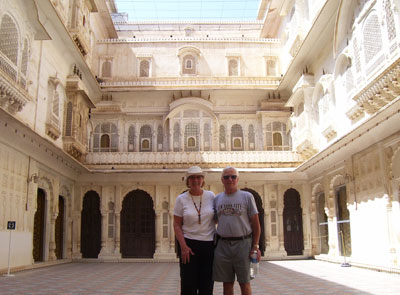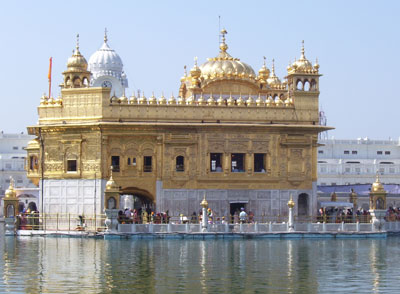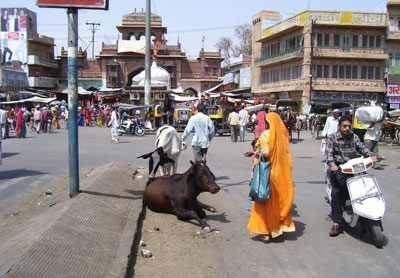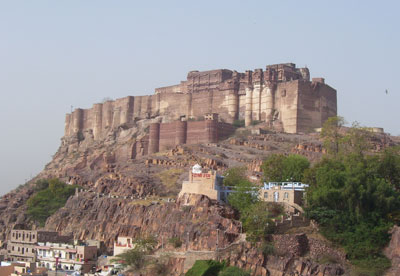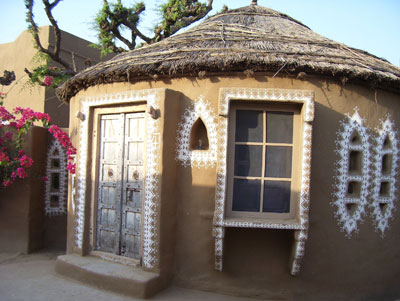Embracing the vibrancy of Rajasthan on a flexible car-and-driver tour
by Marvin Herman & Judy Licata; Delavan, Wisconsin
Looking for a different style of travel for our first visit to a country where we felt we would need some on-site guidance, my wife, Judy, and I opted for a journey through India with a private car and driver. With our accommodations all booked in advance, we hoped we would be allowed to set our own pace and avoid the “bags out by 7 o’clock” grind of group travel.
Making arrangements
Through a reference from friends, we booked our trip with Royal Expeditions (phone 404/993-6116 [No. America sales office], www.royalexpeditions.com), based in New Delhi. Although we would be tempted to stay longer, we limited our time in India to three weeks and concentrated on the state of Rajasthan in the north of India, although we also planned to see the Taj Mahal, in Uttar Pradesh, and travel by train from Delhi to Amritsar, in the Punjab region, to see the Golden Temple, the holiest shrine of the Sikh religion.
We liked the fascinating array of accommodations which the company presented, including historical sites and havelis (former mansions of the merchant class) as well as an upscale camp in the Thar Desert. For the most part, they didn’t disappoint.
We left Chicago on March 10, 2009, flying direct to New Delhi on American Airlines ($1,100 each). We found late March to be an ideal time to travel in the area, just before the unbearable heat of summer comes to the desert.
The total cost of our experience was under $10,000 for the two of us, including air, meals, guides, site entrance fees, tips and a little shopping.
Getting started
Intrepid travelers in our early 70s, we were not daunted by the November ’08 terrorist attacks in Mumbai, although we learned that tourism in the country was down substantially and we encountered few Americans in our travels.
Except for our last night in India, we spent our New Delhi nights at The Claridges, a quiet, nicely maintained hotel with a good supply of hot water plus air-conditioning, cable TV and soft sheets — all necessities in fighting the jet lag of a 14-hour flight.
In each city visited, Royal Expeditions provided a local guide to conduct us around its major sites.However, having read quite a bit about the places we would visit before we left home, we found the local guides to be something of an irritation and we eventually learned to dismiss them or cut them short when we wanted to move on.
We also made it clear to the company’s local representatives, before the end of our first week in India, that we would not stand for being pressured to visit certain shops by the guides or the driver. We were not prepared for these tactics and had hoped to avoid them by forgoing the tour-bus routine. Our attitude about these issues seemed to dampen the spirit of our driver, but we remained steadfast in our position.
A highlight of our first day in Delhi was a visit to a Sikh temple, where we watched the service and participated in the meal served to all who cared to partake, regardless of faith.
Some unusual accommodations
The next day we were driven to Neemrana. Driving in India is not an activity that ought to be attempted by amateurs. Pedestrians dart into the road, cows stray off the medians, and trucks change lanes without notice. Passing any vehicle of conveyance, whether truck, motorbike, tuk-tuk or camel cart, requires insistent blares of the horn and the constitution of a daredevil, avoiding potholes as you go.
After several hours we reached the Neemrana Fort Palace, a 15th-century heritage resort that has been restored to its former glory. Our room was quite large, with a private balcony offering beautiful vistas of the sparkling pool below and of the rolling countryside. In late afternoon, a nice, complimentary tea, including both sweet and savory treats, was served in an outdoor area.
By prearrangement, we met our driver the next morning for our four-hour drive to Mandawa Desert Resort, where we were to stay for two nights. On arrival, we were assigned a private “hut” constructed of mud and featuring a huge bedroom with a large, hard bed as well as a large bathroom with a shower. Good air-conditioning and hot water were also provided.
Hotel impressions
On the second day after our arrival in the desert, our driver collected us for the ride to Bikaner, with a stop to visit Junagarh Fort. After a tour of the fort with a local guide and then a tuk-tuk ride through the bazaar there, we crossed the street for lunch at Gallops (Court Road), a polo-themed restaurant with framed photographs of the Bikaner teams. There we enjoyed a tikka dish, cooked in a clay oven, along with warm, garlicky, buttery naan bread.
Touring finished for the day, we were driven to Gajner Palace, a beautiful heritage hotel/hunting lodge located on a small lake about 15 miles outside Bikaner. We quickly settled in and arranged a ride on the small, solar-powered boat available to guests for rides on the lake. The sun was setting and we enjoyed its beauty along with sightings of peacocks, terns, coots, parrots and other wildlife, such as deer, wild boar and an animal called a blue bull (a type of antelope).
At the conclusion of the boat ride, we walked to the large courtyard to attend a performance given by an energetic family of musicians, singers and dancers at which we were the only audience. This place was going to be hard to leave.
But leave we must — for our five-hour drive to Jaisalmer.
India is very tip-intensive, and at this point in the trip I had become tired of people standing around waiting to be tipped. For example, on check-in at our hotel in Jaisalmer, the Gorbandh Palace, one man took our passport. Two people helped with luggage, another drew the room drapes and still another showed us where the TV remote and the meagerly stocked mini-bar was. Then the man came back with our passports. All of them wanted tips. A few of the hotels had central tip boxes so money could be left at checkout, which I felt was a far better system.
After allowing us some time to relax at the hotel, our driver was back promptly to drive us to Sunset Point, from which we could view the setting sun and the city of Jaisalmer.
Independent touring
The next morning we were off for a tour of the Jaisalmer Fort, but about two hours into the tour Judy became sick with “Delhi belly” and we had to cancel the rest of the day’s activities.
I was thankful that Judy’s malady did not affect the touring plans of others, as might have been the case with group travel. We could continue at a slow pace until she was at full strength again.
A note about the local guides — since they were not part of a coordinated program, they tended to repeat what previous guides had stated as we toured palaces, forts and havelis. On a group tour, there is generally a “national” guide who remains with the group from beginning to end, providing some continuity to the experience.
Some travelers may find this lack of continuity a deficit of “car and driver” touring, but we found it only a minor irritant, far outweighed by the excitement that each new day on the road brought.
Desert experience
The Thar Desert beckoned the next day, so our driver collected us for our trip to Manvar Desert Camp with its luxurious tents, each equipped with a large, full bath and air-conditioning. Judy was feeling somewhat better and was able to make the journey.
Traveling in a passenger vehicle, I had less of a feeling of being cocooned than I do when traveling in a large tour bus. We were independent travelers making our way across a beautiful part of an intriguing country.
At the nearby Manvar Resort, we were assigned a hotel room to use until late afternoon, at which time we took a two-hour jeep ride into the desert.
We sat in the back of the roofless 4-wheel-drive jeep as the driver seemingly flew over “cliffs” of sand, passing blue bulls, peacocks and a herd of wild camels. Then the sky clouded over and it began to rain.
The wind velocity increased, as in a sandstorm, and we rushed to a nearby dwelling, its occupants allowing us to stay until the weather cleared. We got the sand out of our teeth and carried on to our tented camp.
As evening fell, we were led to an outdoor area of the camp set with pillows and small tables and were served appetizers and soup while Indian musicians and dancers performed. Then we walked to the large restaurant tent for a buffet dinner, arriving at our personal tent at about 10:30 under millions of stars.
We were awakened very early the next morning for a camel ride. We rode, two to a camel, to a gentle dune to see the sunrise. Less than an hour later we were back in our tent, and after a nice buffet breakfast we were driven back to the hotel to meet our driver for the two-hour trip to Jodhpur.
Jodhpur
Our hotel in Jodphur, the Ratan Vilas Palace, was built in 1920 by a polo-playing maharajah. Since our tour of the Meherangarh Fort was scheduled for the next morning, the balance of our day was free.
After a couple of hours of relaxation, we had the hotel call our driver and we asked him to take us to the Sardar Market, its tall clock tower marking the center of the city.
We love to shop in this type of bustling atmosphere, and we had an absolutely wonderful couple of hours buying bangles and children’s books of Indian folklore in English while dodging cows, humans, tuk-tuks and camels among the touting of the vendors and the spicy aromas of Jodhpur.
The next morning, after a breakfast of yogurt, fruit, eggs and toast, we met our local guide, a nice young fellow who spoke perfect English. Our driver took us first to Jaswant Thanda, a memorial to a popular 19th-century ruler which includes the cenotaphs of his relatives. The Thanda sits on a natural lake and was a good place from which to view the fort and the Blue City of Jodhpur.
That night, back at the hotel, we experienced the first of several power outages that we came to expect as normal in Rajasthan. The power returned each time within a few minutes.
On to Udaipur
The next stop on our schedule was Udaipur, a six-hour haul. Along the way we visited Ranakpur, a Jain temple complex known throughout India for its grandiose architecture — well worth the visit.
After lunch at a small outdoor tourist café serving an expensive and rather mediocre buffet, we soon reached our hotel, the Jagat Niwas Palace, hidden away at the end of a market street on the shore of Lake Pichola. It was a very well-maintained haveli with a rooftop restaurant. Our room, slightly smaller than what we were used to, had a beautiful view of the lake.
The weather was fine, which meant shopping, so we headed off to the market for several hours of strolling through the town, tasting the fruit we could peel as well as cooked food, including poori (deep-fried bread) and the best gulab jamun (a deep-fried ball of dough soaked in syrup) that we encountered in Rajasthan.
City sights
In the morning, our guide joined us for a walk to the Jagdish Temple, a Hindu temple that we had passed the previous day on our shopping stroll. We checked our shoes at the entrance and ascended the steps of the temple, built in the mid-17th century.
A service was in progress, so we stood at the side of the sanctuary listening to the chanting of the men and women of all ages, expressions of rapture on their faces. I shuffled forward to make a small donation to the temple and, in return, was given a handful of water from the Ganges, which I splashed on my face, being careful to not really drink any. Later, I was given a candy to commemorate the sweetness of life.
We continued on to Udaipur’s City Palace, the largest in Rajasthan, visiting the leafy interior gardens and various rooms decorated with mosaic and mirror. Then we were driven to Sahelion-Ki-Bari, or Garden of the Maids of Honor, a retreat for the ladies of the royal household.
During our vegetarian dinner on the hotel’s rooftop, we could hear the chanting from the Jagdish Temple blended with the restaurant’s sitar music, which floated through the balmy evening air. That night I had a slight bout of stomach upset, doubtless brought on by the accidental ingesting of Ganges water. I took a Pepto-Bismol tablet and was fine by morning.
After a rather mild breakfast of cornflakes in yogurt with toast and sweet black tea, we headed to Deogarh. We reached this small, dusty town and came upon an imposing ochre-colored palace, Deogarh Mahal, our accommodations for the night. A beating of drums announced our presence and, after flower petals were flung in our direction, we sat down for the reception formalities.
Deogarh is a place that not even many locals know about, but it soon became apparent why we were sent there. Our room was a luxurious suite that included a sitting room with a large sofa-swing plus a huge bedroom and glorious bathroom facilities.
Dressed for dinner, we took an audio tour of this 16th-century palace narrated by the well-known author William Dalrymple. It was a wonderful tour, though we found ourselves walking the catwalks and parapets of the palace in the dark.
We opted for the à la carte menu at dinner, which was served by Prakesh Salvi, the best waiter in India. We were given complimentary appetizers and dessert with our vegetarian meal, the tastes of which tingled on my tongue.
Journey to Jaipur
Although we wished we could stay longer, our driver arrived after breakfast to take us on a five-hour obstacle-course drive to Rajasthan’s capital of around 3,500,000 people: Jaipur, the Pink City. He skillfully negotiated his way around pigs, cows, carts, graceful women in brightly colored saris, men in orange turbans with flowing white moustaches, children, goats, bicycles and quite a few speed bumps before we hit the open road, where only the cows held the superior right of way.
By mid-afternoon we reached Jaipur and our accommodation, the 16th-century Alsisar Haveli, located in a rather ramshackle part of town. Our spacious room, decorated in a style evocative of those bygone days when the merchant class had money to burn, overlooked the elegant courtyard.
After a stop at an ATM, our driver dropped us, at our request, at the Tripolia Gate and we walked through the market until our feet were sore, hiring a pedicab (80¢) for the 20-minute ride back to the Alsisar, from which we had a card indicating its location. Weariness had fallen upon us and we abandoned any plan to have dinner outside the Alsisar.
We were awakened the next morning by the muezzin’s call to prayer from a nearby mosque. Our guide and driver met us at 8:30 for the drive to the Amber Fort, where we joined the long line of tourists waiting to board elephants for the ride up to the fort entrance. After our guided tour of the fort, we drove to the City Palace to tour the exceptional Jantar Mantar, an outdoor display of astronomical devices, many invented by Jai Singh II, founder of the city.
We stopped to view the beautifully filigreed Hawa Mahal, or Palace of the Winds, and after a trip back to the hotel our driver took us to the Bapu Bazaar, where we shopped for saris, pashmina shawls and leather goods. There was quite a bit of hassle from the street touts and merchants, but we felt this was a more authentic experience than shopping at the clean, Westernized, higher-priced shops patronized by tour groups.
Again, we made our way back by pedicab, paying 100 rupees ($2) for the rather long ride on this hot day (the thankful driver had asked only 20 rupees).
Agra
On the way to our next destination, Agra — home of the Taj Mahal and a highlight of any trip to the region — we stopped to visit Fatehpur Sikri, briefly a capital of Rajasthan.
The city was built by the Mughal Emperor Akbar in the 16th century in honor of the Sufi who, after Akbar repeatedly failed to produce an heir, correctly predicted that he would sire three sons. It was pleasant to walk in and refreshingly uncrowded, though children hounded us each step of the way.
Reaching Agra, we checked into The Gateway Hotel, where we had booked a Taj-view room. We informed the local guide that we wished to see the Sadar Bazaar and asked him the cost of a tuk-tuk to take us there. The guide told us that there were “many Muslims in Agra” and that it was not safe for tourists to travel alone there. He suggested that we have our driver take us there and wait for us.
Our guide asked us what goods we were interested in and offered to accompany us to shop for marble, rugs and gems, but we informed him that we wanted to shop on our own. We had our driver take us to Sadar and told him we would find our own way back, though he was quite willing to wait for us.
We found the bazaar to be a modern market without the charm of those we had visited in Jodhpur and Jaipur. We did, however, stop for some street food and Judy charmed the vendors, who posed for a photo with her. We took a tuk-tuk back to The Gateway and had felt no danger anywhere we shopped in Agra, including near the hotel, which our guide also portrayed as a dangerous area.
Before bed, we looked out the window for the Taj but, alas, it is not lit up at night.
We were up before dawn to see the Taj Mahal at sunrise, which was an awesome sight. One simply can’t stop looking at its perfection.
After our tour we visited some of the stalls outside the grounds and, to the consternation of our local guide, bought an ostrich-feather fan from a young street seller. We had assumed the feathers were fake since the fan was very inexpensive, but we were told that ostriches are often killed for their feathers. Moreover, purchases from minors by tourists tend to encourage the kids to forgo their education for street work. Thus chastised, we were careful not to repeat our transgression.
Heading to Amritsar
After breakfast back at the hotel and a tour of Agra Fort, we returned to New Delhi and The Claridges, calling it a night early since we needed to be up in time to catch the 7:20 train to Amritsar, near the Pakistan border. Amritsar is the site of the beautiful Sikh Golden Temple.
We checked in at The Claridges, then took the short walk to Gandhi Smriti (formerly known as Birla House), a memorial to the Gandhi freedom movement. This museum includes appealing dioramas of the life of the great man as well as placards with some of his famous pronouncements, all housed in the former home of supporters of the Mahatma.
The attached bookshop had a list of every book ever read by Gandhi (he was a big fan of Tolstoy). After the building closed, we wandered the peaceful gardens.
We were awake by 5:30 the next morning to go to the train station. Our train pulled out on time and soon we were looking out the window at the extensive slums of Delhi. But for this train journey, we would not have seen this seamy side of the city.
We rolled into the Punjab region heading toward Amritsar and were met on our arrival by a driver who took us to the remotely located Mrs. Bhandari’s Guest House. Our room was just around the corner from a shallow pool of mud where a small herd of water buffalo stood lazily flicking their tails. The manager showed us around the property, describing the house rules for the honor-system refrigerator.
We were hungry and, as our driver was not scheduled to return until late afternoon, we hired a tuk-tuk (20 rupees) to take us to town. From the list of recommended restaurants posted near the check-in desk, we selected The Brothers (phone +91 183 6941881 www.thebrothersdhaba.com), which billed itself as “The No. 1 Dhaba (Punjabi restaurant) in Amritsar.”
We opted for the Vegetable Special Thali, a meal served with several small dishes, including rice, yogurt, daal and curry, along with naan; our meal cost about $10, with beverages. The place was packed with people, and we were clearly the only non-Indians in the place. It was a great experience, another that we would not have had on a group tour.
After a little shopping, we returned to the guest house via tuk-tuk.
The rooms at Mrs. Bhandari’s were well below the standard set on our trip, to this point, but we were there for only one night. Our room was crawling with mosquitoes and other insects, and there was no hot water. What water there was barely dripped from the faucet.
Grand sights
Our guide came for us late in the afternoon to take us to the Pakistan border for the changing-of-the-guard ceremony, called the Wagah Border Ceremony, which takes place there each evening. About 30,000 people gather for the lowering of the flags on each side of the border in an exercise of nationalism for both countries, the governments of which are still in contention over the control of Kashmir.
On this night there were just a few Westerners in attendance. We got to sit up close in the VIP section to watch the high-stepping uniformed border guards in their cockaded hats performing the ceremony.
After breakfast the next morning, we continued on to the Golden Temple of the Sikhs. We secured orange kerchiefs as head coverings and, thus adorned, checked our shoes and walked to a holy lake where people were bathing, the temple gleaming over the water in the mid-morning sun.
After about an hour in line, we reached the point where we could hear the service in progress, which was much like the one we attended on our first day in New Delhi but on a mammoth scale.
We also visited the temple complex’s kitchens, where the dough for the thousands of chapatis (flat breads) baked there each day is made and where big metal containers of spicy daal are filled and refilled. Tens of thousands of people are fed each month, all with volunteer help and donations.
The temple itself, a wonder of inlaid marble, had several levels, all of which were engaged in prayer services throughout the day.
Next we visited the spot where Indira Gandhi’s police killed hundreds of innocent Sikhs, during what was known as Operation Blue Star, as well as the scene of the 1919 massacre of peaceful protesters by British Indian Army soliders at Jillianwalla Bagh, a public garden in Amritsar, viewing the bullet-riddled walls and the eternal flame memorial.
A rewarding destination
Finally, it was time to take the train back to Delhi. As experienced train travelers, we relaxed in our seats until almost midnight, when we arrived at our final hotel, Silver Ferns, where we arranged for a late checkout.
On our last day in India (our flight was scheduled to leave just after midnight), we visited the National Museum, taking the audio tour, which was good as long as we could find the corresponding numbers on the exhibits. However, the museum was largely disappointing, with shabby rooms and several exhibits that were closed or missing, which was attributed to its being the end of the tourist season.
This three-week trip was our first car-and-driver experience, and in most ways we felt that we got closer to seeing the real India in our own way, seeing many things that we would not have seen on a group tour.
On the other hand, people who choose to travel this way must understand that the group dynamic will be missing and they will have to solve their own problems.
Whichever mode of travel you choose, India is a most remarkable destination.


